Grumman F6F-3 Hellcat
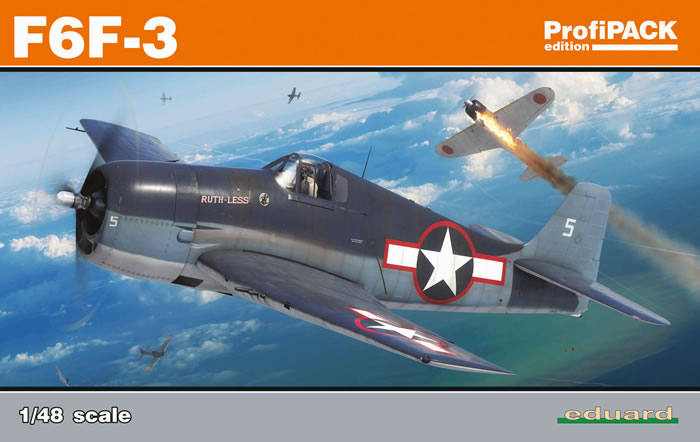
Eduard ProfiPACK, 1/48 scale
S
u m m a r y |
| Catalogue Number and Price: |
Eduard Kit No. 8227 - F6F-3 Profipack
USD$49.99 plus shipping available online from Eduard
GBP£29.99 EU Price (£24.99 Export) plus shipping available onlune from Hannants
|
| Scale: |
1/48 |
| Contents and Media: |
105 grey injected moulded parts, 16 clear parts, 70 photoetched parts, 4 Brassin resin parts, masks, decals and comprehensive instructions. |
| Review Type: |
FirstLook |
| Advantages: |
Crisp yet subtle moulding with superb detail, Eduard’s usual high quality instructions. A nice choice of schemes and Hellcat versions. A bonus set of really nice resin wheels. |
| Disadvantages: |
No alignment pins, some rough plastic, control surfaces not separate. |
| Conclusion: |
A great kit of the Hellcat F6F-3 from Eduard with everything included to make a highly detailed model with some different schemes from previous boxings. |
Reviewed by David Couche

Eduard's 1/72 scale Fw 190 A-5/A-8 Grunherz Limited Edition Dual Combo
is available online from Squadron.com
The Grumman F6F Hellcat is an American carrier-based fighter aircraft of World War II. Designed to replace the earlier F4F Wildcat and to counter the Japanese Mitsubishi A6M Zero, it was the United States Navy's dominant fighter in the second half of the Pacific War. The Hellcat competed with the faster Vought F4U Corsair for that role and prevailed, as the Corsair had significant issues with carrier landings. The Corsair, instead, was primarily deployed to great effect in land-based use by the U.S. Marine Corps.
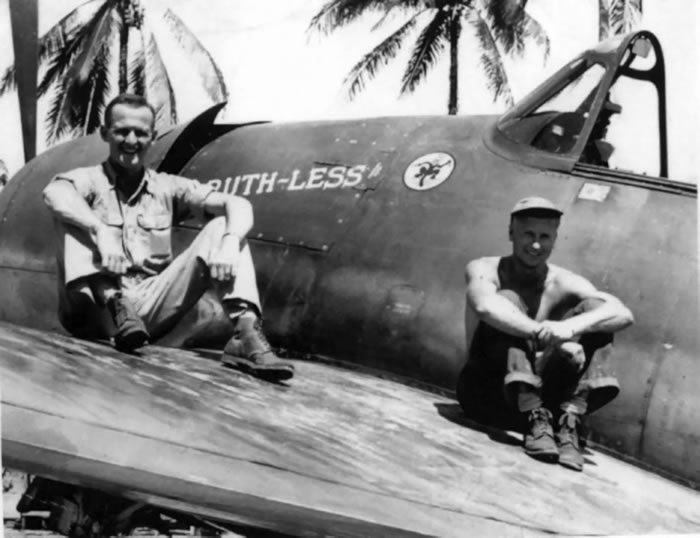
Powered by a 2,000 hp (1,500 kW) Pratt & Whitney R-2800 Double Wasp, the same powerplant used for both the Corsair and the United States Army Air Forces (USAAF) Republic P-47 Thunderbolt fighters, the F6F was an entirely new design, but it still resembled the Wildcat in many ways. Some military observers tagged the Hellcat as the "Wildcat's big brother".
The F6F made its combat debut in September 1943, and was best known for its role as a rugged, well-designed carrier fighter, which was able to outperform the A6M Zero and help secure air superiority over the Pacific theatre. A total of 12,275 were built in just over two years of which 4402 were the F6F-3 version.
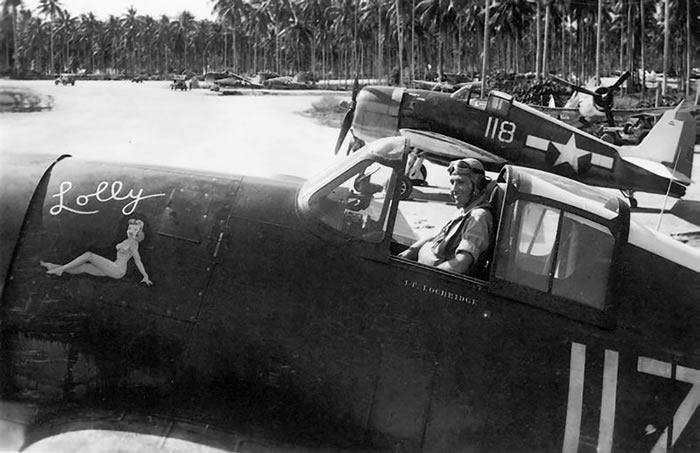
Hellcats were credited with destroying a total of 5,223 enemy aircraft while in service with the U.S. Navy, U.S. Marine Corps, and Royal Navy Fleet Air Arm. This was more than any other Allied naval aircraft. Post-war, the Hellcat was phased out of front-line service, but remained in service as late as 1954 as a night fighter.
Eduard first released the F6F-3 Hellcat kit in 2008. At the time it was the best and most accurate Hellcat produced. Since then it has been released in a number of different boxing’s including Dual Combo’s, Royal Class and Weekend Editions. This recent boxing basically sees the same kit in the box but with 5 new schemes as well as a set of Brassin resin wheels. The sturdy Eduard box is packed full of all the goodies you will need to make a really nicely detailed model of this Hellcat. The contents include, 4 grey injected moulded sprues with some 105 parts on them. Upon careful examination of the instructions I find that 17 of these parts are not to be used in this version, so the spares box will have more welcome additions. There is one clear sprue containing 16 very clear parts, 4 resin parts for the wheels, 2 sheets of photoetch containing 70 parts, a sheet of masks and the usual comprehensive instruction booklet. All sprues are cleanly moulded with no flash evident and sprue gates to the parts appear to have been created to minimise their effect on the parts.
Sprue A
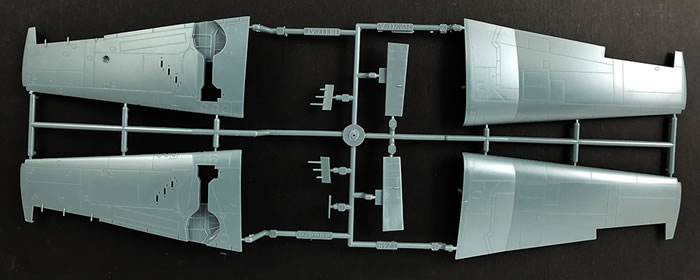
This sprue contains 9 grey injected plastic parts with 1 part not used. The main parts here are the upper and lower wing surfaces, as well as the gun inserts and the ailerons. Detail is a mix of recessed panels and hatch details with some restrained riveting along panel edges. The wheel well has nice detail in it which should paint and weather up a treat.
Sprue C
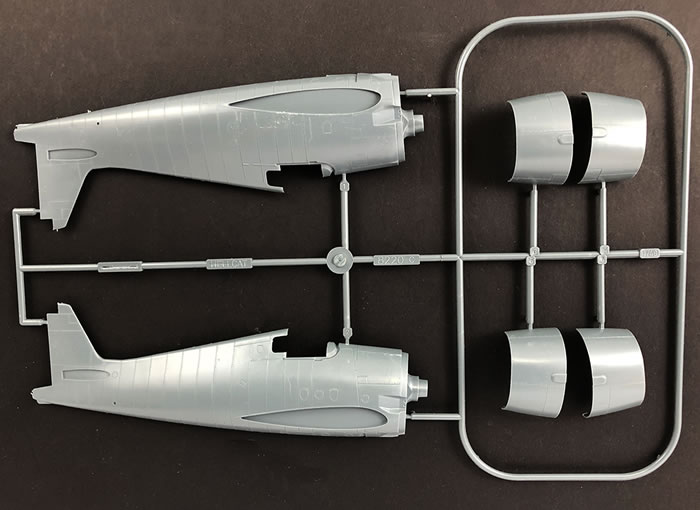
Sprue C has the fuselage halves and 2 sets of engine cowls to choose for different versions. Eduard’s fuselage parts exhibit the overlapping panels that was prominent on the Hellcats. Just as an aside, my box also had Sprue D in it which is the fuselage parts for the -5 version on which is the J part of the sprue which has the 3rd cowl option on it. If you have one of the dual combo kits, the spare set of fuselages will enable you to build 2 of the late versions.
Sprue E
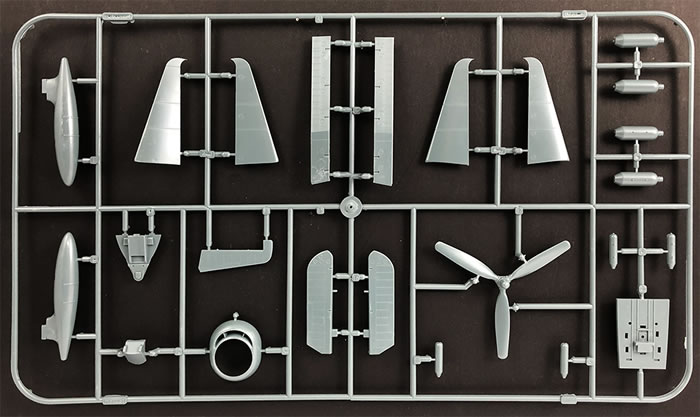
A sprue with 24 parts on it of which 8 are not used. Sprue E has the tailplanes, elevators, flaps, cockpit floor and rear wall, propeller as well as the nose ring and drop tank parts.
Sprues G
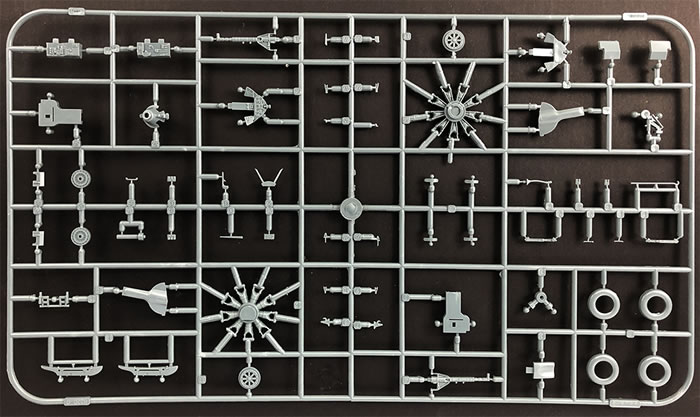
This large sprue has 64 parts on it, with 8 of these unharmed in making the -3 version. This sprue delivers us the undercarriage components, 2 rows of cylinders for the radial engine, tailwheel and a myriad of smaller parts used throughout the model. Again, all parts are nicely moulded showing little in the way of flash or bad mould seams which is good for a set of moulds that have done a great deal of work over 11 years.
Sprue J
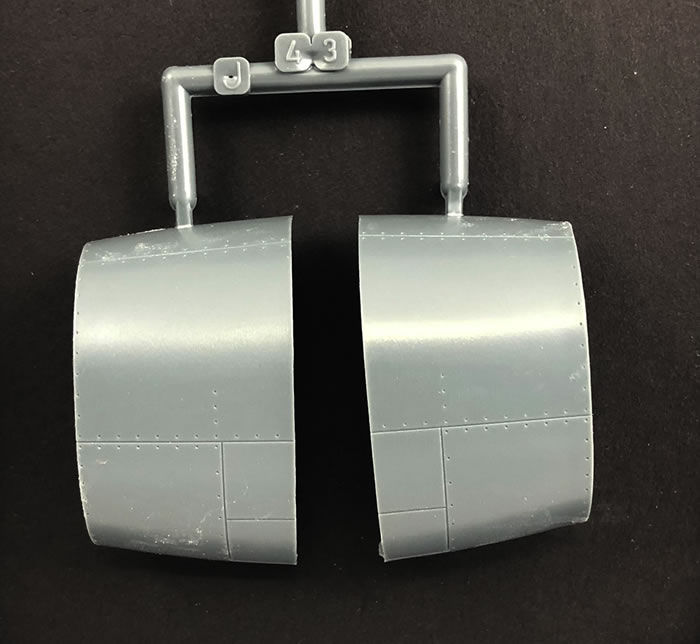
Sprue J has the 2 parts of the 3rd option of cowl panels, in this case for schemes B and E.
Sprue H
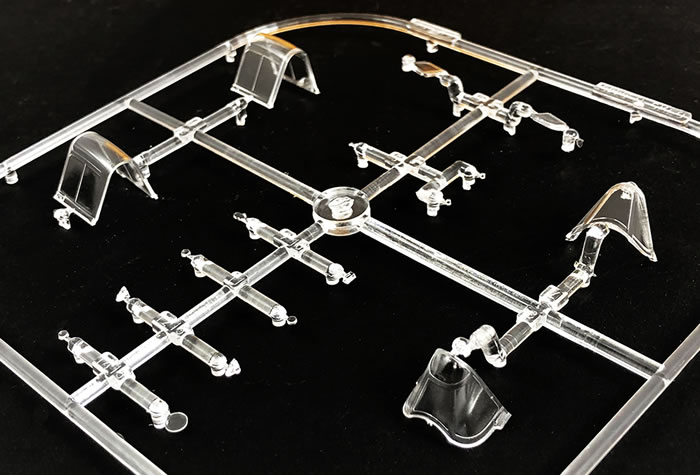
Here we have the clear sprue of 16 parts with the -5 front canopy the only part not used. There are optional parts of the sliding section of the canopy for closed and open positions. There are also a number of lights provided as well as the small rear windows and gunsight parts. All parts are very clear with nice detail where supplied.
Photoetched Frets

There are 2 very nice photoetch sheets of 70 parts included in the Profipack which includes pre-coloured seat belts and instrument panel as well small additions to the cockpit.
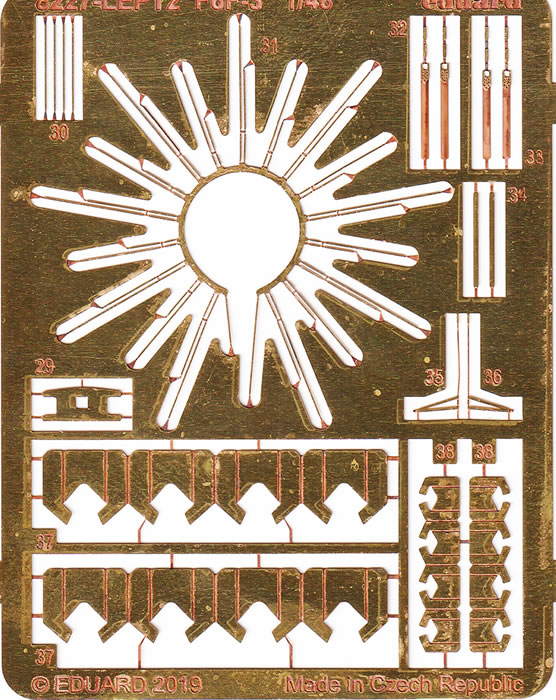
A sheet of plain brass etch has parts for the wiring loom of the engines, braces for the drop tank and 4 other larger parts which are not mentioned in the instructions, therefore I put down as not to be used.
Brassin Resin
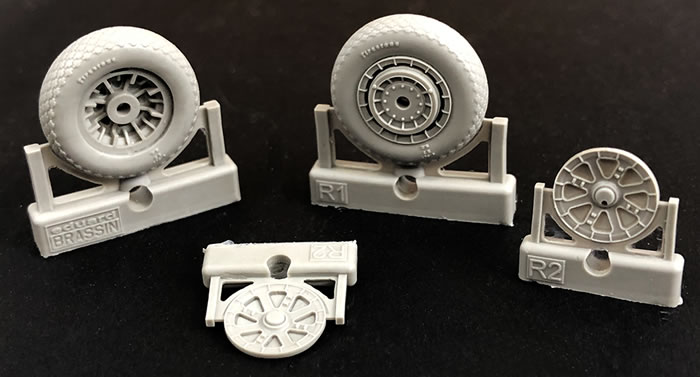
Eduard have provided a beautiful set of Brassin resin wheels in this boxing of the F6F-3 Hellcat. These have wonderfully crisp detailed diamond styled treaded wheels and hubs, which are different on each side. They also supply the option of a set of hub covers that were used on some aircraft. You may need to check your references for these.
Masking Sheet
A sheet of typical Eduard tape style masks completes the kit. These allow for masking of both open and closed canopies as well as masking for the wheel hubs and tail wheel. This is a very useful inclusion.
Instructions and Decals
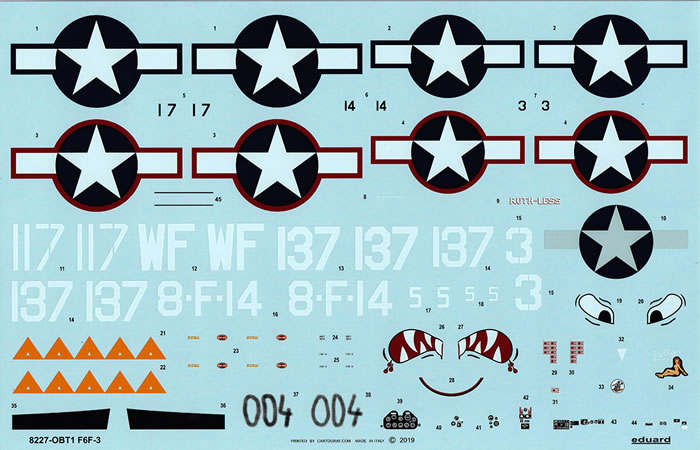
The instructions for the kit are the usual Eduard, high quality detailed instructions, with copious colour call outs throughout, using the Gunze Aqueous and Mr Color range. The decals appear to be in perfect register giving the options for 5 different aircraft. Included is a comprehensive stencil and data sheet, with a separate page at the end of the instructions for their placement.
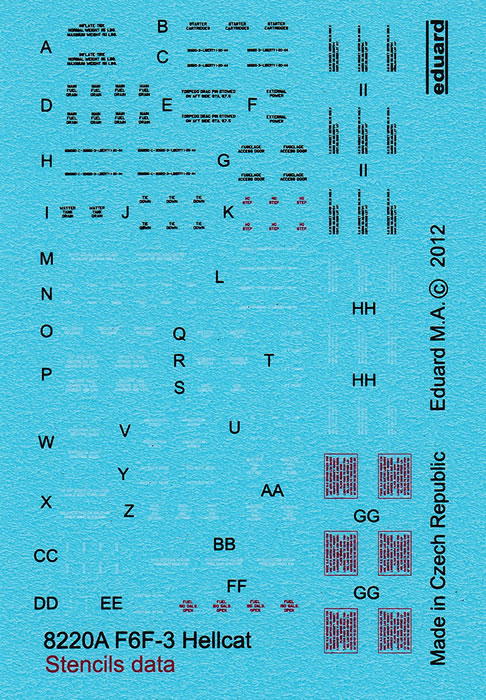
I have included a scan of the 5 aircraft profiles but briefly, they are;
-
F6F-3 , Lt. Oscar Ivan Chenoweth, VF-38, Segi Point, New Georgia Island, September 1943
-
F6F-3 , Ens. Gordon Arthur Stanley, VF-27, USS Princeton (CVL-23), October 1944
-
F6F-3 , VF-8, USS Intrepid, Summer 1943
-
F6F-3 , Lt. Lochridge, VF-34, Nissan Island, 1944
-
F6F-3 , OTU VF-2, NAS Melbourne, United States, October 1944
Please note, I have seen a couple of print magazines lately that mention the last aircraft as being from NAS Melbourne, Australia…… NAS Melbourne is actually now Orlando Airport, Florida… Hellcats never flew out of Australia.
This is a very nice, well detailed kit. The Eduard F6F-3 kit ticks all the right boxes, a great choice of schemes covering a range of schemes used in the Pacific theatre of operations.
Thanks to Eduard for the sample
Review Text Copyright © 2019 by David Couche
Page Created 20 September, 2019
Last updated
20 September, 2019
Back to HyperScale Main Page
Back to Reviews Page Woo! |
